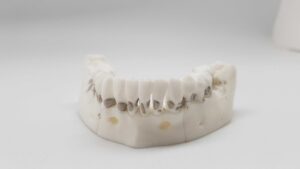Periodontal Non-Surgical Root Debridement Model Trainer
________________________________________
Problem Statement
The removal of bacterial plaque biofilm and its by-products e.g. calculus (mineralised plaque), is the gold standard treatment for the management of periodontitis. It is, however, a blind process and one can only depend on tactile sensation to check if the bacterial plaque and/or calculus has been removed. As such, it is difficult for a novice to appreciate the intricacies involved in root debridement, for example, the adaptation of the curette blade against the root surface.
The current root debridement training model uses a commercially available nail varnish to mimic calculus. It is not ideal because of the following reasons:
- Inaccurate representation of natural teeth
- it feels too smooth and too rubbery compared to calculus, which is rough and hard
- it can be peeled off as one layer, which does not happen with actual calculus. Less force is required to remove it compared to removing calculus on natural teeth.
- no demarcation between enamel and cementum
- It is expensive and only good for three practice sessions.
- Some ingredients used may cause allergic reaction.
Objective
This project aims to create a model that mimics root surfaces with subgingival calculus to allow enhanced training of dental undergraduates so that they can better treat their periodontal patients by maximising the clinical efficiency and effectiveness of root debridement.
Key Benefits/ Outcomes
- A Standardised Periodontal Non-Surgical Root Debridement Model Trainer is successfully designed and manufactured. The model provides more accurate tactile feedback and can be mounted easily on existing training simulator Oscar.
- At this moment, there is no realistic root debridement training models in the market. As such, this training model has great potential as it can be used by dentists for the training for periodontal and dental implant related procedures or surgeries. The training models could be used to standardise both training and assessment purposes for postgraduate trainees or undergraduate students in dental schools.

Various materials and printers experimented to achieve the accurate representation of natural teeth.

A Standardised Periodontal Non-Surgical Root Debridement Model Trainer fabricated using additive manufacturing.



